Part of the What is Your Purpose series

 How great would it be if your audience knows exactly what you want them to know?
How great would it be if your audience knows exactly what you want them to know?
- No confusion
- All their questions answered
- The perfect communication
Perfect communication may be unattainable, but to achieve your purpose, anticipating your audience’s questions helps. Do you have the know-how for better business communication?
What You Want Others to Know
In the post, How business communication fails on purpose, you received three simple questions for planning your business communication. This post addresses the first question.
What do you want your audience to know?
The #1 tip for communicating what you want others to know is:
Get your audience to listen.
I know – DUH! But doing that may be tougher than you think.
If you’re more the visual type, you can get a high-level view of this post with the video shown below. It updated the SlideShare presentation from the original post publication.
In the Know
All of us enter a discussion with our own ideas and experiences. Today maybe more than ever. That can be a real challenge, as illustrated below.
Michael was ready. He spent a lot of time preparing for his presentation.
- He knew his product was the answer.
- The challenge was getting the audience to listen.
- Michael had a list of benefits and ideas for making it work.
Then this happened.
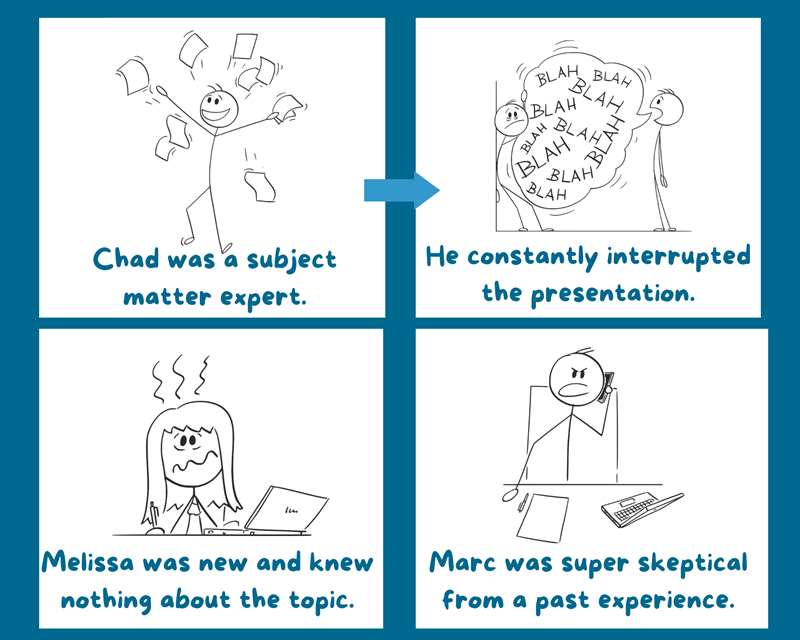
With any of the above scenarios, chances are good the individual will shut down completely or stop listening. But you can grab a person’s attention and keep it.
Connect what the person knows with something better.

1. Connect the dots.
Provide a meaning or purpose for what you’re communicating. Explain how your product works and how that helps a situation that your audience relates to.
For example, as our personal and business lives moved online, a new kind of disorder emerged. Lost documents, missing photos, disorganized information quickly became chaos.
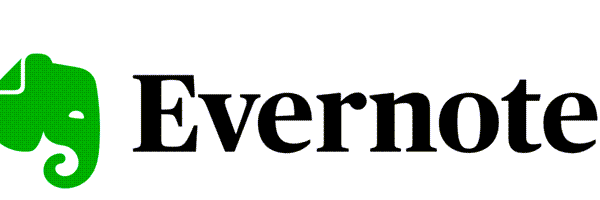
The organizing tool, Evernote, uses the simple explanation (shown below) to relate to its user.
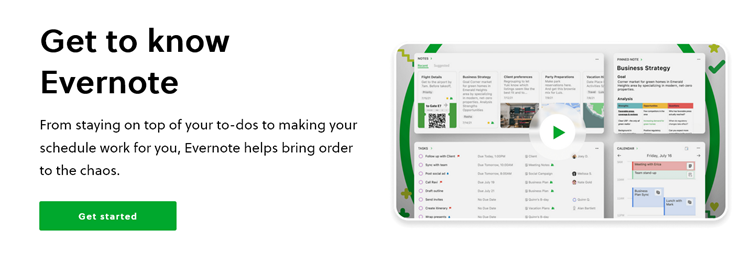
The tool offers ideas to connect its product to the organization its customer wants.
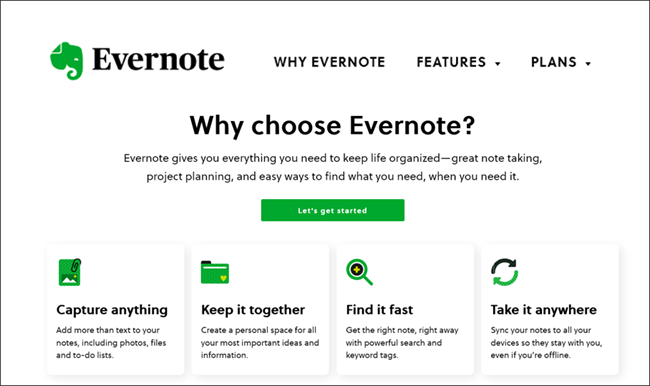
2. Make it relevant.
Think about the questions your product creates for someone who is unfamiliar with it – What is it? What is it to me? How does it help?
The Evernote example does all that.
- Visitors to its site learn what the tool is.
- It gives examples of tasks each person can relate to.
- And establishes how the tool helps organize their lives.
3. Put your unique stamp on it.
Audience members shut down when they’ve heard it all before. Expect skepticism and address what makes your offer unique.
Remember Michael? He is a small business owner. Often, his biggest competitor is a mega company that mass produces his product. So, what is unique about what Michael offers?
- His smaller scale allows for more customization.
- Michael’s business can give the customer the tweaks they want.
- The business is more personal.
A Framework to Meaning
Michael had never met Chad, Melissa, or Marc. That’s often the case when you’re marketing or posting to social media. So, how do you connect the dots and make it relevant?
Deliver the framework for your audience to build their own meaning.
The following are a few ideas how to do that.
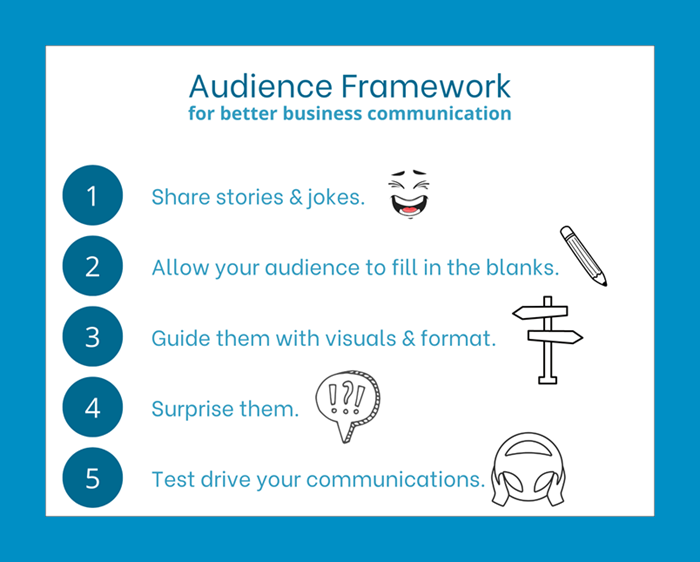
1. Share stories and jokes (if you’re good at it).
Sharing stories and telling jokes puts your audience at ease.
- They relate what you shared with their own circumstances.
- You made what you shared relevant.
- You put your unique stamp on the story.
But don’t overdo the stories and jokes. Make sure the story fits. Otherwise, it becomes distracting and downright annoying.
2. Allow your audience to fill in the blanks.
Filling in the blanks is not leaving your audience hanging with no answers. Instead, you encourage discovery based on their own experience.
One of the best examples of this is Nike’s iconic Just do it.

- Before Just do it, most viewed the Nike brand as merchandise for professional athletes.
- The simple tagline ignited a new audience – weekend warriors and non-athletes.
- Each person put their personal spin on Just do it.
3. Guide them with visuals and format.
Images are visual road signs to guide your audience. Combine images with formatting that draws attention to what you’re trying to tell them.
Visual signs are the hook that draws people in.
Your audience can see the direction you are pointing to. Although they may decide on a different route.
Look at the homepage of Helix mattresses for an example of combining images and formatting to convey product options.
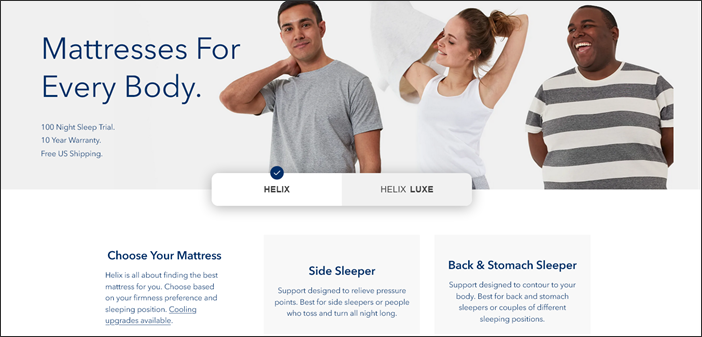
Helix guides visitors to selections based on their preferences (mattress firmness, sleeping positions). I love how the site depicts the firmness options.

4. Surprise them.
Is your communication too predictable? It’s like knowing a novel’s ending before you get halfway through it. Why would you read on?
Great novelists know how to keep the element of surprise. Some of the ways you can do that may be…well… a surprise.
Interesting Statistics
Who would think statistics could be anything but boring? But I promise you, you can find some intriguing facts on just about any topic.
- Think about your product or topic.
- Next, search for related statistics.
- Interesting statistics grab your audience’s attention and stay with them.
For example, in honor of Helix, let’s look at statistics about sleep. Sleep Foundation has several fascinating facts about sleep, such as the one shown below.

So, how could you use that to make your point? Here’s an example. Use the above image to share your statistic.
Are you dreaming of a better night’s sleep? Start with your perfect mattress.
Unexpected Gifts
Remember Oprah’s surprise giveaways? The unsuspecting audience reaped the rewards for showing up that day.
No, I don’t expect you to give every audience member a new car. But what if you automatically entered each member in a giveaway? That’s one way to have a bigger surprise.
Or you could give away free copies of your book, or product, or some other valued gift.
Can the Cliché
Surprise your audience by leaving out overused presentation “tricks”. Like overused business phrases, the tricks may have been creative – at first. But overuse moves them into the cliché category.
A quick search discovered complaints about the following presentation tactics.
- Close your eyes and picture (something)
- Raise your hand if this ever happened to you
- Today I’m going to talk about…
- How you all doing? (Or other cheerleading type maneuvering)
If you want audiences to listen, can the cliché and give them something different.
5. Test-drive your communication.
If you want others to know what it is you’re communicating, take it for a test drive first. Ask others to provide feedback so you can check if they get it. The following are a few samples to gather their perspective.
- What do I like/dislike about this business communication?
- How would I describe the writing?
- Is there a clear message?
- Do I gain anything from reading it?
- Would I recommend the product/service/article to someone else?
Know it All
So, if you want your audience to listen, give them a framework that piques their interest. Then guide them to something better – like your business. 😊
What tips do you have to better communicate what you want others to know? Share your tips in Comments.
Note: The next post reviews how you communicate what you want your audience to feel.
==================================
==================================
Note: This post originally published on April 25, 2016. This September 1, 2022 version updates it.
===================================

0 Comments